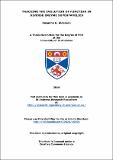Files in this item
Tracking the evolution of function in diverse enzyme superfamilies
Item metadata
| dc.contributor.advisor | Mitchell, John B. O. | |
| dc.contributor.author | Alderson, Rosanna Grace | |
| dc.coverage.spatial | 200 p. | en_US |
| dc.date.accessioned | 2017-03-20T14:10:19Z | |
| dc.date.available | 2017-03-20T14:10:19Z | |
| dc.date.issued | 2016-06-22 | |
| dc.identifier | uk.bl.ethos.707259 | |
| dc.identifier.uri | https://hdl.handle.net/10023/10496 | |
| dc.description.abstract | Tracking the evolution of function in enzyme superfamilies is key in understanding how important biological functions and mechanisms have evolved. New genes are being sequenced at a rate that far surpasses the ability of characterization by wet-lab techniques. Moreover, bioinformatics allows for the use of methods not amenable to wet lab experimentation. We now face a situation in which we are aware of the existence of many gene families but are ignorant of what they do and how they function. Even for families with many structurally and functionally characterized members, the prediction of function of ancestral sequences can be used to elucidate past patterns of evolution and highlight likely future trajectories. In this thesis, we apply in silico structure and function methods to predict the functions of protein sequences from two diverse superfamily case studies. In the first, the metallo-β-lactamase superfamily, many members have been structurally and functionally characterised. In this work, we asked how many times the same function has independently evolved in the same superfamily using ancestral sequence reconstruction, homology modelling and alignment to catalytic templates. We found that in only 5% of evolutionary scenarios assessed, was there evidence of a lactam hydrolysing ancestor. This could be taken as strong evidence that metallo-β-lactamase function has evolved independently on multiple occasions. This finding has important implications for predicting the evolution of antibiotic resistance in this protein fold. However, as discussed, the interpretation of this statistic is not clear-cut. In the second case study, we analysed protein sequences of the DUF-62 superfamily. In contrast to the metallo-β-lactmase superfamily, very few members of this superfamily have been structurally and functionally characterised. We used the analysis of alignment, gene context, species tree reconciliation and comparison of the rates of evolution to ask if other functions or cellular roles might exist in this family other than the ones already established. We find that multiple lines of evidence present a compelling case for the evolution of different functions within the Archaea, and propose possible cellular interactions and roles for members of this enzyme family. | en_US |
| dc.language.iso | en | en_US |
| dc.publisher | University of St Andrews | |
| dc.rights | Creative Commons Attribution-NonCommercial-NoDerivatives 4.0 International | |
| dc.rights.uri | http://creativecommons.org/licenses/by-nc-nd/4.0/ | |
| dc.subject | Evolution | en_US |
| dc.subject | Enzyme | en_US |
| dc.subject | Function | en_US |
| dc.subject | Superfamilies | en_US |
| dc.subject | Phylogenetics | en_US |
| dc.subject | Ancestral sequence reconstruction | en_US |
| dc.subject | Homology modeling | en_US |
| dc.subject | Bioinformatics | en_US |
| dc.subject | Sequence alignment | en_US |
| dc.subject | Drug discovery | en_US |
| dc.subject.lcc | QP601.A63 | |
| dc.subject.lcsh | Enzymes | en |
| dc.subject.lcsh | Molecular eveolution | en |
| dc.subject.lcsh | Drugs--Design | en |
| dc.title | Tracking the evolution of function in diverse enzyme superfamilies | en_US |
| dc.type | Thesis | en_US |
| dc.contributor.sponsor | Biotechnology and Biological Sciences Research Council (BBSRC) | en_US |
| dc.type.qualificationlevel | Doctoral | en_US |
| dc.type.qualificationname | PhD Doctor of Philosophy | en_US |
| dc.publisher.institution | The University of St Andrews | en_US |
This item appears in the following Collection(s)
Except where otherwise noted within the work, this item's licence for re-use is described as Creative Commons Attribution-NonCommercial-NoDerivatives 4.0 International
Items in the St Andrews Research Repository are protected by copyright, with all rights reserved, unless otherwise indicated.


